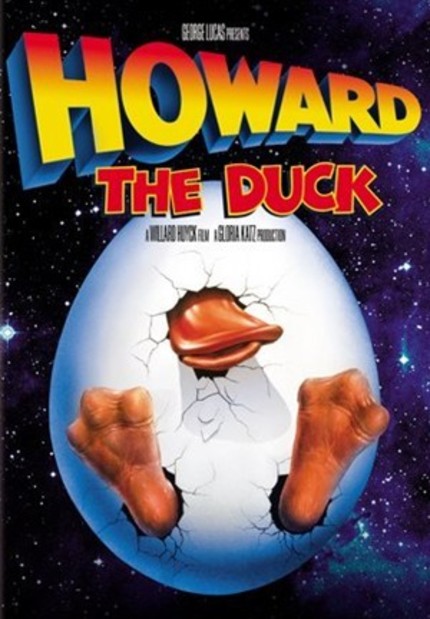Comics On Screen: HOWARD THE DUCK

Setting aside the fact that The Incredible Hulk was a regular feature on American TV screens until finally being canceled in 1982, we can safely put forth the notion that 1979's Captain America 2: Death Too Soon effectively crippled Marvel live-action production. It wouldn't be until 1986 that another Marvel property would make a live-action appearance in a feature-length motion picture, and it wasn't the property that anyone would have expected.
Howard the Duck was produced by George Lucas, fresh from completing the original Star Wars trilogy, as well as producing the second Indiana Jones film Indiana Jones and the Temple of Doom. He was looking for something new to sink his teeth into, and to start what would hopefully be a new major franchise, Lucas turned to the husband and wife writing team he had worked with years earlier on American Graffiti, Willard Huyck and Gloria Katz.
And the opening moments of the film are intriguing. The Duckworld setting is heavily detailed, with movie posters, family photos, mail, books, magazines, television programs, everything. Even parts of his apartment that are only passed over for a few seconds are filled with Duckified details.
Then he is suddenly, literally, yanked away from his world. He flies through the walls of his apartment building, busting through the bedroom of an older Duck couple and the bathroom of a nude lady-Duck who is apparently too busy masturbating to notice the destruction.
And as tasteless and weird as that sounds, it's still promising. Unfortunately, it isn't followed up on in any meaningful way. If the writers wanted to really make this something special, then the source materials provide them with all sorts of solid, edgy content
Instead, everything that made the comics groundbreaking and unique is whitewashed away, leaving behind nothing much more than a bad pun-spewing duck and an unengaging story about the End of the World.
With occasional bizarre sexual titillations and teases.
In an interview from 2001, Howard's creator, Steve Gerber, had this to say about the film:
The film, in a misguided attempt to appeal to a mass audience, turned Bev into a rock star and told a rather simple-minded alien monster story. There were some nice performances in the film - Jeffrey Jones was particularly funny, and Lea Thompson as Beverly was very pleasant to look at - but it wasn't Howard the Duck.
And that's the problem.
When the filmmakers made fundamental changes to the characters' personalities and histories in earlier Marvel movie instances, they still worked, so why get hung up on changes when the character's an anthropomorphic duck?
It's simple, really.
Howard the Duck wasn't just a humor comic. Howard wasn't a comical character. None of those previous attempts ever consciously betrayed the heart of the characters.
Screenwriter, Gloria Katz, says, "It's a film about a duck from outer space... It's not supposed to be an existential experience... We're supposed to have fun with this concept, but for some reason reviewers weren't able to get over that problem."
But Howard the Duck was always an existential experience. That's what made it special. Without that, the film version of Howard the Duck is nothing if not an insulting, dumbed-down, complete misreading of the source material.
There are a few highlights, though.
The songs were written and the performances were choreographed by a young Thomas Dolby, and aside from the awful sad song in the middle of the film, the other songs, "Hunger City" and "Howard the Duck" are actually pretty catchy. It helps that George Clinton co-wrote "Howard the Duck."
Which explains the line, "If it ain't funk, he don't feel it."
Lea Thompson as Beverly is okay. She's cute and energetic, giving it everything she's got. There's just nothing in the script for her to work with. She was just off of Back to the Future and in the course of a year or so had incredible career highs and then this amazing low.
Ed Gale, who plays Howard, also does amazing work given the limitations he had to work through. He was almost completely blind in the duck suit, only being able to see when the mouth was open. Director/writer Willard Huyck originally hired a 12-year old boy to play Howard, and Gale was hired as his stunt double/stand-in. However, when shooting conditions became too much for the child (limited hours, claustrophobic suit, etc.) Gale stepped up and won the role.
The best performance in the film, though, belongs to Jeffrey Jones as Doctor Jenning/Dark Overlord of the Universe. His gradual transformation into the Dark Overlord almost makes up for a lot of the bad stuff in this film. His movement and voice work, combined with a fairly disturbing make-up progression, make his gradual change into a monster quite unnerving.
When the Dark Overlord finally appears in his true form at the end of the film, it is thanks to the stop-motion animation of Phil Tippett. This is probably the best part of the entire film. The design of the beast is like a combination of a giant scorpion and, um, something else. It finds a nice middle ground between threatening and amusing, and shows up the rest of the visual effects in the film.
But this shouldn't be a surprise, really. Tippett does amazing work whatever he's tasked to do. In 1981 he co-developed the Go-Motion animation technique for Dragonslayer. He also worked on Return of the Jedi (1983) and designed the animated sequences in Robocop (1986).
Ultimately, Howard the Duck is not "for iconoclasts" (as Lea Thompson says), and it didn't become "a cult movie because people understand the absurdity of it" (as Katz says). It was a poorly conceived and poorly executed, overly expensive betrayal of the original concept.
By Paul Brian McCoy







